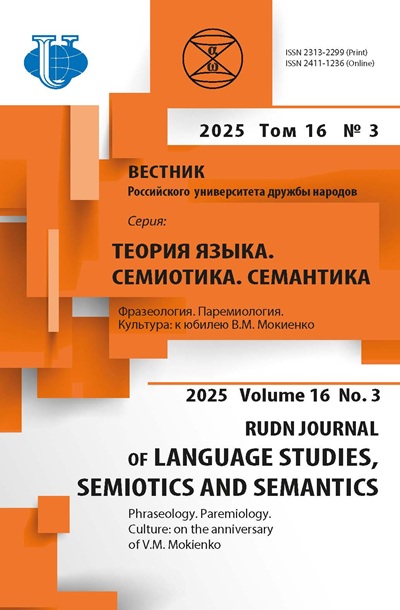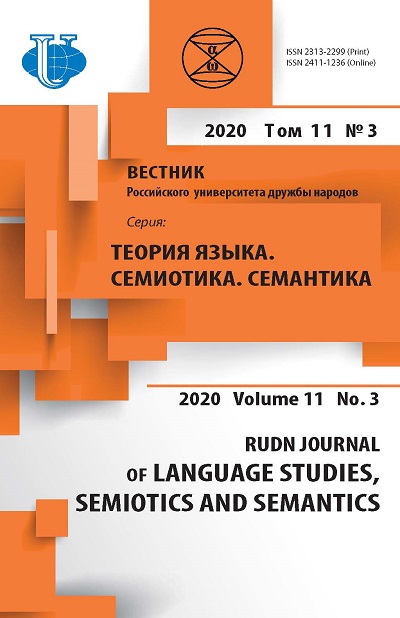Босния и Герцеговина - исторический мост между балканскими культурами, религиями и нациями
- Авторы: Савченко А.В.1, Хмелевский М.С.2
-
Учреждения:
- Государственный университет Чжэнчжи
- Санкт-Петербургский государственный университет
- Выпуск: Том 11, № 3 (2020)
- Страницы: 545-559
- Раздел: КОГНИТИВНЫЕ ИССЛЕДОВАНИЯ В ЯЗЫКЕ
- URL: https://journals.rudn.ru/semiotics-semantics/article/view/24605
- DOI: https://doi.org/10.22363/2313-2299-2020-11-3-545-559
- ID: 24605
Цитировать
Полный текст
Аннотация
В статье представлены основные факты пересечения славянской, восточной и европейской культур в самом центре Балканского полуострова, в исторической ретроспективе рассматриваются их особенности и анализируются связи православного, католического и мусульманского миров, которые нашли отражение в менталитете жителей Боснии и Герцеговины: в культуре, этнографии и языке. Особое внимание уделяется конкретным аспектам современной жизни, а также социальным проблемам, особенностям национального менталитета, традициям и обычаям разных этносов (сформировавшихся в результате конфессиональных различий), проживающих на территории современной Боснии и Герцеговины. На основе проводимого в статье анализа показана специфика и уникальность данного балканского региона: с одной стороны, славянского, а с другой, - не являющегося таковым в культурологическом и мировоззренческом смысле этого слова. В работе также продемонстрированы стереотипные представления народов бывшей Югославии о мусульманской части населения Боснии и Герцеговины, которые нашли свое отражение в современной культуре, литературе и языке всех современных народов Южной Славии. В настоящем исследовании впервые делается вывод о том, что помимо традиционно принятых в науке понятий Slavia Orthodoxa («православная Славия») и Slavia Romana («католическая Славия»), на Балканах с XVI века начал формироваться третий мир - Slavia Muslim («мусульманская Славия») со своим особым своеобразным и локально ограниченным менталитетом, культурой, религией и языком.
Об авторах
Александр Викторович Савченко
Государственный университет Чжэнчжи
Автор, ответственный за переписку.
Email: savchenko75@mail.ru
кандидат филологических наук, ассистент-профессор кафедры славянских языков и литератур
64/2, улица Джинань, 116, Вэньшань, г. Тайбэй, Тайвань, 195249Михаил Сергеевич Хмелевский
Санкт-Петербургский государственный университет
Email: chmelevskij@mail.ru
кандидат филологических наук, доцент филологического факультета
Университетская наб., 11, г. Санкт-Петербург, Российская Федерация, 195249Список литературы
- Jelavich B. History of the Balkans, Vol. 1: Eighteenth and Nineteenth Centuries. Cambridge: Cambridge University Press, 1983.
- Хмелевский М.С. Отражение истории, культуры и традиций Боснии в языке и фразеологии // Studia Slavica Academiae Scientiarum Hungaricae. 2015. no 60 (1). С. 79—86. DOI: https://doi.org/10.1556/060.2015.60.1.8.
- Browne W. Serbo-Croat // The Slavonic languages, Bernard Comrie and Greville G. Corbett (eds.). London—New York: Routledge, 1993. P. 306—387.
- Fishman J.A. The Language Factor in National Development // Anthropological Linguistics. 1962. no 4 (1). pp. 23—27.
- Greenberg R.D. Language and identity in the Balkans: Serbo-Croatian and its disintegration. Oxford: Oxford University Press, 2008.
- Bugarski R. Language, nationalism and war in Yugoslavia // International Journal of the Sociology of Language. 2001. no 151. pp. 69—87. DOI: https://doi.org/10.1515/ijsl.2001.048.
- Bugarski R. Language policies in the successor states of former Yugoslavia // Journal of Language and Politics. 2004. no 3 (2). pp. 189—207. DOI: https://doi.org/10.1075/jlp.3.2.04bug.
- Bugarski R. Portret jednog jezika / Urednik Ivan Čolović. Biblioteka XX vek, Knj. 201. Beograd: Knjižara krug, 2012.
- Katičić R. Undoing a “Unified Language”: Bosnian, Croatian, Serbian // Undoing and Redoing Corpus Planning. Clyne M. (ed.). Berlin: Mouton de Gruyter, 1997. pp. 165—191.
- Pohl H.D. Serbokroatisch — Rückblick ind Ausblick. In: Wechselbeziehungen zwischen Slawischen Sprachen, Literaturen und Kulturen in Vergangenheit und Gegenwart. Ingeborg Ohnheiser (ed). Innsbruck: Istitut für Sprachwissenschaft, 1996. pp. 205—221.
- Mazower M. The Balkans. Short History. New York: Modern Library, 2002.
- Pramenković A. Muslims and Christians in the Balkans: Historical Aspect and Contemporary Challenges Dialogue without Alternative // Milel ve Nihal: Inanç, Kültür ve Mitoloji Araştirmalari. 2012. no 9 (2). pp. 113—122.
- Anderson B. Imagined Communities: Reflections on the Origin and Spread of Nationalism. London, New York: Verso, Revised edition, 2006.
- Labov W. Sociolinguistic Patterns. Philadelphia: University of Pennsylvania Press, 1972.
- Isanović-Hadžiomerović A. Islamic Education in the Balkans // Daun H., Arjmand R. (eds.) Handbook of Islamic Education. International Handbooks of Religion and Education, 7. Springer, Cham, 2018. DOI: https://doi.org/10.1007/978-3-319-64683-1_47.
- Karčić F. The Bosniaks and the challenges of modernity: Late Ottoman and Habsburg times. Sarajevo: El-Kalem, 1999.
- Friedman F. Bosnia and Herzegovina: A polity on the brink. London and New York: Routledge. Taylor & Francis Group, 2006.
- Nasr S. H. Islam: Religion, history, and culture. New York: HarperCollins, 2009.
- Smajić A. Bosnia and Herzegovina // J.S. Nielsen et al. (eds.), Yearbook of Muslims in Europe, 6. Leiden: Brill, 2014. pp. 108—127.
- Tollefson J.W. (2002). The language debates: preparing for the war in Yugoslavia, 1980—1991 // International Journal of the Sociology of Language. 2002. no 154. pp. 65—82.
- Lovrenović I. Bosanski Hrvati. Esej o agoniji jedne evropsko-orijentalne mikrokulture. Zagreb: Durieux, 2002.
- Кузнецова И.В. Устойчивые сравнения с персонажами Библии в языках бывшей Югославии // Studia Slavica Academiae Scientiarum Hungaricae. 2017. no 62 (1). pp. 77—90. DOI: https://doi.org/10.1556/060.2017.62.1.7.
- Хмелевский М.С. Особенности фразеологии города Сараево // Национальное и интернациональное в славянской фразеологии. Грайфсвальд: Ernst-Moritz-Arndt-Universität, 2013. С. 227—231.
- Fischer B.J. (eds.). Balkan Strongmen: Dictators and Authoritarian Rulers of South Eastern Europe. West Lafayette, Indiana: Purdue University Press, 2007.
- Halilović S., Tanović I., Šehović A. Govor grada Sarajeva i razgovorni bosanski jezik. Sarajevo: Slavistički komitet, 2009.
- Andrić I. (1946). Letter from the Year 1920. Режим доступа: https://ia801009.us.archive.org/ 32/items/LetterFromTheYear1920_201804/Letter from the Year 1920.pdf. (дата обращения: 17.02.2020).
- Bursać A. Bosnian, Croatian, Serbian, a Grammar with Sociolinguistic Commentary. Wisconsin: The University of Wisconsin Press, 2006.
- Škiljan D. Standard Languages in Yugoslavia. In: Language Planning in Yugoslavia. Bugarski R. and Hawkesworth C. (eds.). Columbus: Slavica Publishers, Inc., 1992. pp. 27—42.
- Crnobrnja M. The Yugoslav drama. McGill-Queen’s University Press, 1996.
- Kovačić M. Serbian and Croatian: One language or languages? // Jezikoslovlje. 2005. no 6 (2). pp. 195—204.
- Staničić L. Jezička politika i nominacija u Bosni i Hercegovini za vrijeme austrougarske uprave. In: Književni jezik u Bosni i Hercegovini od Vuka Karadžića do kraja austrougarske vladavine. München: Slavica Verlag Kovač, München, 1991. pp. 99—119.
- Vujičić D. Naziv jezika i upotreba pisama u Bosni i Hercegovini u vrijeme austrougarske okupacije // Naučini sastanak slavista u Vukove dane. 1980. no 9. pp. 181—187.
- Šehović A., Haverić Đ. Leksika orijentalnog porijekla u frazemama bosanskog jezika. Sarajevo: Filozofski fakultet u Sarajevu, 2017.
- Jahić Dž., Halilović S., Palić I. Gramatika bosanskog jezika. Zenica: Dom štampe, 2000.
- Škaljić A. Turcizmi u srpskohrvatskom jeziku. Sarajevo: Svjetlost, 1989.
- Roberts W.R. Tito, Mihailović, and the Allies, 1941—1945. New Brunswick, New Jersey: Rutgers University Press, 1973.
- Hunter T.Sh. God on Our Side: Religion in International Affairs. Lanhan, Boulder, New York, London: Rowman & Littlefield Publishers, 2017. DOI: https://doi.org/10.1080/ 13510347.2016.1268124.
Дополнительные файлы












